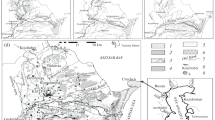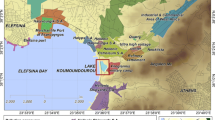Abstract
Significant degradation of the Agrakhan Bay on the eastern coast of the Terek River delta has occurred in the course of the 20th century as a result of the combined action of natural and anthropogenic factors. Comprehensive studies conducted by the authors in 2018–2020 have made it possible to describe the main causes of this degradation, characterize the current state of the reservoir, and establish scientific bases under recommendations for its improvement. It has been demonstrated that as a result of partial drying and reduction of water surface area the bay has lost its former importance as a spawning and rearing water body providing the West Caspian region with the younglings of valuable commercial fish species. By 2018, the catches decreased by ten times compared to the early 20th century with sturgeons having almost totally disappeared. The state of the northern part of the bay, which has transformed into a group of shallow water bodies almost entirely separated from each other and from the sea is particularly unfavourable. The study of hydrological and morphological, hydrobiological, fishery-related and hydrochemical parameters has shown that the improvement of the wetlands at the former bay site is possible. Detailed analysis of the water balance using multivariate limnological calculations has shown that there is enough water for watering and partial restoration of the water bodies of the Agrakhan Bay hydrographic system. Clearing of silted and overgrown canals, deepening and berming of the remaining water bodies, and directing the necessary amounts of river water into Northern and Southern Agrakhan Bay (in accordance with the calculated delivery schedule) will allow reduction of the overgrowing and siltation of water bodies, restore the water exchange between them, improve water quality, revive the fishery industry in the region, improve the habitats of many rare and protected animal species, and increase the recreational attractiveness of the region.







Similar content being viewed by others
REFERENCES
Abdusamadov, A.S., Musaev, P.G., Grigor’yan, O.P., Barkhalov, R.M., Akhmaev, E.A., and Taibov, P.S., Perspective directions for the development of fisheries in the Terek-Caspian fishery sub-area, Yug Rossii: Ekologiya, Razvitie, 2014, vol. 9, no. 3, pp. 36–43.
Baidin, S.S., Skriptunov, N.A., Gann, G.N., and Shteinman, B.S., Hydrology of the mouth area of the Terek and Sulak, Tr. Gos. Okeanogr. Inst., 1971, no. 109.
Bukreev, S.A. and Dzhamirzoev, G.S., Importance of IBAs and PAs of Dagestan in the conservation of rare bird species, in Inventarizatsiya, monitoring i okhrana klyuchevykh ornitologicheskikh territorii Rossii. Vyp. 7. Materialy nauchno–prakticheskogo soveshchaniya “Klyuchevye ornitologicheskie territorii Rossii i problemy ikh okhrany”, posvyashchennogo 20–letiyu programmy KOTR (Inventory, Monitoring and Protection of Key Ornithological Territories in Russia, Vol. 7: Proc. Sci.-Pract. Meeting “Key Ornithological Territories of Russia and Problems of Their Protection”, Dedicated to the 20th Anniversary of the IBA Program), Moscow: SOPR, 2016, pp. 70–81.
Daniyalova, N.V. and Nadiradze, A.A., Ispol’zovanie biologicheskikh resursov Dagestanskogo rybopromyslovogo raiona Kaspiiskogo basseina (Use of Biological Resources of the Dagestan Fishing Region of the Caspian Basin), Moscow: Nauka, 1984.
Demin, D.Z., Puti rybokhozyaistvennoi rekonstruktsii gidrograficheskoi struktury del’ty r. Terek v usloviyakh ponizhennogo urovnya Kaspiiskogo morya (Ways of Fishery Reconstruction of the Hydrographic Structure of the Terek River Delta in the Conditions of the Low Level of the Caspian Sea), 1963, pp. 170–175.
Ekologiya zarastayushchego ozera i problema ego vosstanovleniya (Ecology of an Overgrown Lake and the Problem of Its Restoration), Drabkova, V.G. and Prytkova M.Ya., Eds., St. Petersburg: Nauka, 1999.
Gorelits, O.V. and Zemlyanov, I.V., Stages of development of the Terek delta in modern conditions, Tr. Gos. Okeanogr. Inst., 2011, no. 213, pp. 369–380.
Hipsey, M.R., Bruce, L.C., and Hamilton, D.P., GLM – General Lake Model: Model Overview and User Information. AED Report no. 26, Perth: University of Western Australia, 2014, p. 26.
Instruktsii po sboru i pervichnoi obrabotke materialov vodnykh bioresursov Kaspiiskogo basseina i sredy ikh obitaniya (Instructions for the Collection and Primary Processing of Materials from Aquatic Biological Resources of the Caspian Basin and Their Habitat), Astrakhan: Kasp. Nauchno–issled. Inst. Rybn. Khoz., 2011.
Katanskaya, V.M., Vysshaya vodnaya rastitel’nost' kontinental’nykh vodoemov SSSR: Metody izucheniya (Higher Aquatic Vegetation of Continental Water Bodies of the USSR: Study Methods), Leningrad: Nauka, 1981.
Magritskii, D.V., Kravtsova, V.I., and Samokhin, M.A., Agrakhansky Bay in the Terek Delta and its morphological degradation, in Zakonomernosti proyavleniya erozionnykh i ruslovykh protsessov v razlichnykh prirodnykh usloviyakh: Materialy V Vserossiiskoi nauchnoi konferentsii s mezhdunarodnym uchastiem (Patterns of the Manifestation of Erosion and Channel Processes in Various Natural Conditions: Proc. V All–Russian Conf. with Int. Participation, Moscow, September 3–6, 2019), Moscow: Mosk. Gos. Univ., 2019, vol. 1, pp. 290–291.
Magritsky, D.V., Samokhin, M.A., Sokolov, D.I., Erina, O.N., Goncharov, A.V., Tereshina, M.A., Surkov, V.V., Moreido, V.M., Arkhipkin, V.S., and Semenova, A.A., Modern Hydrological and Morphological State of the Agrakhan Bay and Its Adverse Changes, in IOP Conference Series: Earth and Environmental Science, Bristol: IOP Publishing, 2021, vol. 834, pp. 1–8.
Mikhailov, V.N., Mikhailova, M.V., and Magritskii, D.V., Osnovy gidrologii ust’ev rek: Uchebnoe posobie (Fundamentals of Estuarine Hydrology: Textbook), Moscow: Triumf, 2018.
Pravdin, I.F., Agrakhan Bay and Its Fishery Importance, Izvestiya Otdeleniya Prikladnoi Ikhtiologii, 1925, vol. 3, no. 2, pp. 121–124.
Prikaz Minsel’khoza Rossii ot 31 marta 2020 g. № 167 “Ob utverzhdenii Metodiki ischisleniya razmera vreda, prichinennogo vodnym biologicheskim resursam” (Order of the Ministry of Agriculture of Russia No. 167 “On Approval of the Methodology for Calculating the Amount of Damage Caused to Aquatic Biological Resources”, dated March 31, 2020), Moscow, 2020.
Samokhin, M.A., Magritskiy, D.V., Sokolov, D.I., Erina, O.N., Goncharov, A.V., Surkov, V.V., Semenova, A.A., Zavadskiy, A.S., Vorontsov, A.A., and Tereshina, M.A., The water pools of the Agrakhan bay area in the Terek river delta and scientifically based measures for their conservation, Limnology and Freshwater Biology, 2020, no. 4, pp. 935–936.
Semenova, A.A., Magritskii, D.V., Samokhin, M.A., Sokolov, D.I., Erina, O.N., Goncharov, A.V., Surkov, V.V., Zavadskii, A.S., Sheremetskaya, E.D., and Vorontsov, A.A., Hydrological and morphological degradation of the Agrakhan Bay: Features, causes, solutions, in Chetvertye Vinogradovskie chteniya. Gidrologiya ot poznaniya k mirovozzreniyu (The Fourth Vinogradov Readings. Hydrology from Knowledge to Worldview), St. Petersburg: VVM, 2020, pp. 524–529.
Serdtse Nizhneterech’ya – ozero Yuzhnyi Agrakhan (The Heart of the Lower Terechye is Lake Southern Agrakhan Bay), El’darov, E.M, Ed., Moscow: Bookvika, 2014.
Ust’ya rek Kaspiiskogo regiona: Istoriya formirovaniya, sovremennye gidrologo–morfologicheskie protsessy i opasnye gidrologicheskie yavleniya (Mouths of the Rivers of the Caspian Region: History of Formation, Modern Hydrological and Morphological Processes and Dangerous Hydrological Phenomena), Mikhailov, V.N., Ed., Moscow: GEOS, 2013.
Funding
Materials collection and analysis was supported by the State Contract with the West Caspian Basin Water Management Board (grant no. NIR-18-01). Manuscript preparation was supported by the State Task (TsITIS no. 121051400038-1) within the framework of the Research Project of the Department of Land Hydrology of the Department of Geography of the Moscow State University.
Author information
Authors and Affiliations
Corresponding authors
Ethics declarations
No experimentation involving animals or human was performed by any of the authors.
Conflict of interest. The authors declare no conflict of interest.
Additional information
Translated by E. Martynova
Rights and permissions
About this article
Cite this article
Magritskii, D.V., Goncharov, A.V., Moreido, V.M. et al. Hydroenvironmental State of the Agrakhan Bay and Means for Improvement. Arid Ecosyst 12, 481–495 (2022). https://doi.org/10.1134/S207909612204014X
Received:
Revised:
Accepted:
Published:
Issue Date:
DOI: https://doi.org/10.1134/S207909612204014X




